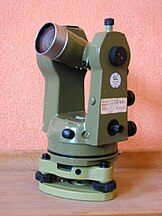Equipment

Hardwareedit
The main surveying instruments in use around the world are the theodolite, measuring tape, total station, 3D scanners, GPS/GNSS, level and rod. Most instruments screw onto a tripod when in use. Tape measures are often used for measurement of smaller distances. 3D scanners and various forms of aerial imagery are also used.
The theodolite is an instrument for the measurement of angles. It uses two separate circles, protractors or alidades to measure angles in the horizontal and the vertical plane. A telescope mounted on trunnions is aligned vertically with the target object. The whole upper section rotates for horizontal alignment. The vertical circle measures the angle that the telescope makes against the vertical, known as the zenith angle. The horizontal circle uses an upper and lower plate. When beginning the survey, the surveyor points the instrument in a known direction (bearing), and clamps the lower plate in place. The instrument can then rotate to measure the bearing to other objects. If no bearing is known or direct angle measurement is wanted, the instrument can be set to zero during the initial sight. It will then read the angle between the initial object, the theodolite itself, and the item that the telescope aligns with.
The gyrotheodolite is a form of theodolite that uses a gyroscope to orient itself in the absence of reference marks. It is used in underground applications.
The total station is a development of the theodolite with an electronic distance measurement device (EDM). A total station can be used for leveling when set to the horizontal plane. Since their introduction, total stations have shifted from optical-mechanical to fully electronic devices.
Modern top-of-the-line total stations no longer need a reflector or prism to return the light pulses used for distance measurements. They are fully robotic, and can even e-mail point data to a remote computer and connect to satellite positioning systems, such as Global Positioning System. Real Time Kinematic GPS systems have increased the speed of surveying, but they are still only horizontally accurate to about 20 mm and vertically to 30–40 mm.
GPS surveying differs from other GPS uses in the equipment and methods used. Static GPS uses two receivers placed in position for a considerable length of time. The long span of time lets the receiver compare measurements as the satellites orbit. The changes as the satellites orbit also provide the measurement network with well conditioned geometry. This produces an accurate baseline that can be over 20 km long. RTK surveying uses one static antenna and one roving antenna. The static antenna tracks changes in the satellite positions and atmospheric conditions. The surveyor uses the roving antenna to measure the points needed for the survey. The two antennas use a radio link that allows the static antenna to send corrections to the roving antenna. The roving antenna then applies those corrections to the GPS signals it is receiving to calculate its own position. RTK surveying covers smaller distances than static methods. This is because divergent conditions further away from the base reduce accuracy.
Surveying instruments have characteristics that make them suitable for certain uses. Theodolites and levels are often used by constructors rather than surveyors in first world countries. The constructor can perform simple survey tasks using a relatively cheap instrument. Total stations are workhorses for many professional surveyors because they are versatile and reliable in all conditions. The productivity improvements from a GPS on large scale surveys makes them popular for major infrastructure or data gathering projects. One-person robotic-guided total stations allow surveyors to measure without extra workers to aim the telescope or record data. A fast but expensive way to measure large areas is with a helicopter, using a GPS to record the location of the helicopter and a laser scanner to measure the ground. To increase precision, surveyors place beacons on the ground (about 20 km (12 mi) apart). This method reaches precisions between 5–40 cm (depending on flight height).
Surveyors use ancillary equipment such as tripods and instrument stands; staves and beacons used for sighting purposes; PPE; vegetation clearing equipment; digging implements for finding survey markers buried over time; hammers for placements of markers in various surfaces and structures; and portable radios for communication over long lines of sight.
Softwareedit
Land surveyors, construction professionals, and civil engineers using total station, GPS, 3D scanners, and other collector data use Land Surveying Software to increase efficiency, accuracy, and productivity. Land Surveying Software is a staple of contemporary land surveying.
Typically, much if not all of the drafting and some of the designing for plans and plats of the surveyed properties is done by the surveyor, and nearly everyone working in the area of drafting today (2020) utilizes CAD software and hardware both on PC, and more and more in newer generation data collectors in the field as well. Other computer platforms and tools commonly used today by surveyors are offered online by the U.S. Federal Government, such as the National Geodetic Survey and the CORS network, to get automated corrections and conversions for collected GPS data, and the data coordinate systems themselves.
Comments
Post a Comment